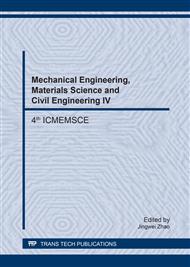[1]
C. Brecher, A. Lempicki, H. Lingertat, S. R. Miller, J. Glodo, and V. K. Sarin. A Ceramic Version of the LSO Scintillator. Transac. Nuc. Sci. 56(2008)1149-1154.
DOI: 10.1109/tns.2007.914368
Google Scholar
[2]
W.M. William. Current trends in scintillator detectors and materials. Nuc. Instrum. Met. Phy Res. 487(2002)123-127.
Google Scholar
[3]
M.J. Weber. Scintillation: mechanisms and new crystals. Nuc. Instrum. Met. Phy Res. 527(2004): 9-16.
Google Scholar
[4]
Y. Takayuki. Study of rare-earth-doped scintillators. Opt. Mater. 35(2013)1997-(2004).
Google Scholar
[5]
S.E. Derenzo, M.K. Klintenberg, M.J. Weber. The quest for the ideal inorganic scintillator. Nuc Instrum. Met. Phy Res. 505(2003)111-118.
Google Scholar
[6]
C. Dujardin, J.M. Nedelec,C. Mansuya, R. Mahiou . Characterization and scintillation properties of sol–gel derived Lu2SiO5: Ln3+(Ln = Eu , Ce, and Tb) powders. Opt. Mater. 31(2009)1334-1339.
DOI: 10.1016/j.optmat.2008.10.008
Google Scholar
[7]
L.H. Qin, S. Lu, D.Z. Ding, G.H. Ren. Color center and radiation center in Lu2SiO5: Ce crystal. Jour. Rare. Ear. 26(2008): 678-685.
DOI: 10.1016/s1002-0721(08)60161-1
Google Scholar
[8]
C. Mansuy, J. M. Nedelec, R. Mahiou. A New Sol-Gel Route to Lu2SiO5(LSO) Scintillator: Powders and Thin Films. Chem. Mater. 16(2004)242-248.
DOI: 10.1002/chin.200346012
Google Scholar
[9]
Y. Shi, P. Yun, D. Zhou, J.J. Xie. Hydrothermal synthesis of Ce: Lu2SiO5 scintillator powders.J. Rare. Ear. 28(2008)800-808.
DOI: 10.1016/s1002-0721(08)60338-5
Google Scholar
[10]
M. Mainas, C. Cannas, A. Musinu, A. Speghini, G. Piccaluga, M. Bettinelli. Nanocrystalline luminescent Eu3+doped Y2SiO5prepared by sol-gel technique. Opt. Mater. 28(2006)1504-1514.
DOI: 10.1016/j.optmat.2005.01.008
Google Scholar
[11]
J.K. Lee, D.W. Cooke, R. Groves, B.L. Bennett, E.A. McKigney, J L.G. Jacobsohn. Luminescent properties and reduced dimensional behavior of hydrothermally prepared Y2SiO5: Ce nanophosphors. App. Phy. Let. 89(2007): 103-108.
DOI: 10.1063/1.2183737
Google Scholar
[12]
C.F. Yan, J. Xu ,G.J. Zhao, L.H. Zhang. Comparison of cerium-doped Lu2Si2O7 and Lu2SiO5 scintillators. J. Crys. Gro. 281(2006) 411-418.
DOI: 10.1016/j.jcrysgro.2005.04.038
Google Scholar
[13]
H. Zhang, J.D. Chen, H. Guo. Electrospinning synthesis and luminescent properties of Lu2O3: Eu3+ nanofibers. J. Rare. Ear. 29(2011)230-239.
DOI: 10.1016/s1002-0721(10)60331-6
Google Scholar
[14]
O. Myeongjin, H.J. Kim. Luminescence Properties of a Lu2O3: Eu3+nano-phosphor and radiation hardness measurements with a proton beam.J. Kor. Phy Soc. 61(2012)273-280.
DOI: 10.3938/jkps.61.273
Google Scholar
[15]
V.B. Kravchenko, Y.L. Kopylov, N.A. Dulina S.T. Parkhomenko A.S. Tolmachev. Fabbrication and characterization of Eu3+-droped Lu2O3 scintillation ceramics. Opt. Mater. 37(2014)809-820.
DOI: 10.1016/j.optmat.2012.04.020
Google Scholar


